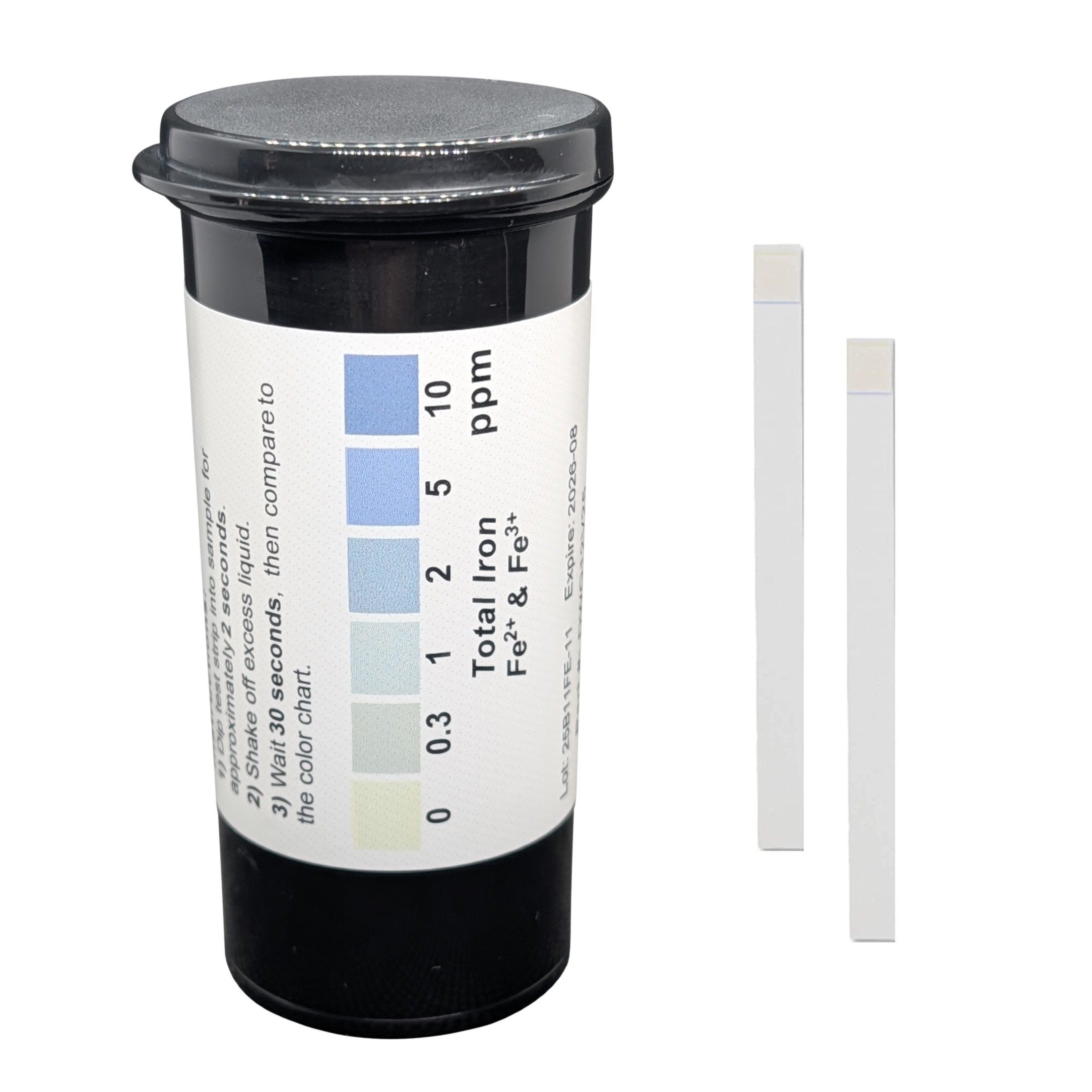Abstract
Iron in water, even at low concentrations, can cause significant operational, aesthetic, and maintenance challenges across industries and households. Traditional iron testing methods often require hazardous chemicals, specialized equipment, trained personnel, and time-consuming procedures. This white paper explores the benefits of rapid colorimetric iron test strips, particularly in the context of monitoring the efficiency of KDF (Kinetic Degradation Fluxion) filtration systems. These strips provide near-instant results, detecting both ferric (Fe³⁺) and ferrous (Fe²⁺) iron, making them an efficient and cost-effective solution for field and preliminary screening. Their application ensures optimal iron removal and facilitates timely maintenance of KDF-based filtration systems, improving overall water quality.
1. Introduction
Iron is a naturally occurring element in groundwater and surface water. While essential in trace amounts, elevated iron levels can lead to various problems, including:
- Aesthetic Issues: Reddish-brown staining on plumbing fixtures, laundry, and appliances.
- Taste and Odor Concerns: Metallic or rusty taste and unpleasant smell.
- Industrial Challenges: Disruptions in beverage production, food processing, and manufacturing.
Accurate and timely iron detection is critical for maintaining water quality. This white paper highlights the role of rapid colorimetric iron test strips in monitoring iron levels, particularly when used alongside KDF-85 filtration systems for enhanced water management.
2. The Role of KDF Filtration in Iron Removal
KDF process media are high-purity copper-zinc granules that utilize a redox (oxidation/reduction) reaction to remove contaminants from water. Their effectiveness in iron removal is attributed to:
- Catalytic Conversion: KDF-85 media facilitate the oxidation of soluble ferrous ions (Fe²⁺) into insoluble ferric hydroxide (Fe(OH)₃), which is then easily filtered out.
- Standalone or Combined Use: KDF filtration can function alone or alongside other treatment technologies at the point-of-entry.
3. Advantages of Rapid Colorimetric Iron Test Strips for KDF Monitoring
3.1. Speed and Convenience
- Provides results in under one minute, enabling real-time water quality assessment.
- No need for complex equipment, making it ideal for field testing and on-site evaluations.
- Ensures continued performance by allowing immediate corrective actions if iron levels are elevated.
3.2. Simplicity and Accuracy
- Easy-to-read color blocks with defined indicators at 0, 0.3, 1, 2, 5, and 10 ppm.
- The ability to detect both ferric (Fe³⁺) and ferrous (Fe²⁺) iron ensures comprehensive monitoring.
- Eliminates the need for specialized training and chemicals, reducing potential for user error.
3.3. Field Applicability for KDF Systems
- Portable and user-friendly, ideal for technicians and water treatment professionals.
- Enables frequent monitoring of KDF systems, ensuring they function optimally.
- Reduces reliance on laboratory testing, cutting down costs and turnaround time.
3.4. Cost-Effectiveness and Efficiency
- Affordable solution, with each pack containing 25 test strips.
- Acts as a pre-screening tool to identify water samples that may require further laboratory analysis.
- Helps verify the efficiency of KDF-85 filtration in reducing iron levels before and after installation.
3.5. Enhancing KDF System Performance Through Regular Testing
- Facilitates periodic monitoring to determine when KDF media require backwashing or replacement.
- Ensures consistent iron removal, preventing breakthrough contamination.
- Demonstrates KDF system effectiveness of KDF-85 to users by providing before-and-after iron level comparisons. This can also show the benefits of using KDF-85 over KDF-55 as KDF-85 will remove or reduce iron but KDF-55 will not.
4. Applications of KDF and Iron Test Strips
4.1. Water Treatment
- Monitoring iron levels in municipal water supplies, well water, and industrial wastewater.
- Assessing the effectiveness of KDF-85 filtration in reducing iron content.
4.2. Industrial Use
- Ensuring optimal water quality for beverage production, food processing, and manufacturing.
4.3. Environmental Monitoring
- Evaluating iron contamination in lakes, rivers, and groundwater.
5. Conclusion
Rapid colorimetric iron test strips, when used in conjunction with KDF filtration systems, provide a practical, cost-effective, and efficient method for maintaining water quality. These strips allow for real-time monitoring of iron levels, helping users ensure that KDF filtration is functioning optimally. By facilitating timely backwashing and media replacement, the combination of KDF filtration and test strips enhances operational efficiency, reduces costs, and promotes long-term environmental sustainability.

Total Iron Test Strips for Measuring Water, 0-10 ppm
- Fast & Convenient – Get iron level results in under a minute with no setup, cleanup, or additional equipment needed.
- Easy-to-Read Color Blocks – Clearly defined color indicators at 0, 0.3, 1, 2, 5, and 10 ppm ensure simple and accurate readings.
- Comprehensive Iron Detection – Detects both ferric (Fe³⁺) and ferrous (Fe²⁺) iron for a complete water quality assessment.
- Ideal for Field Testing – Technicians can quickly test multiple samples on-site without requiring a meter or complex procedures.
- Cost-Effective & Efficient – Each pack includes 25 test strips, perfect for routine monitoring and pre-test lab screenings.
